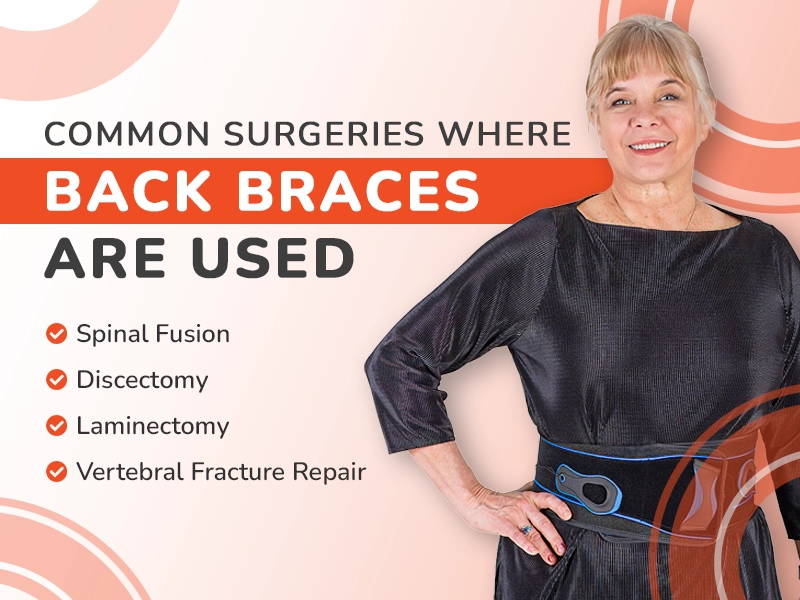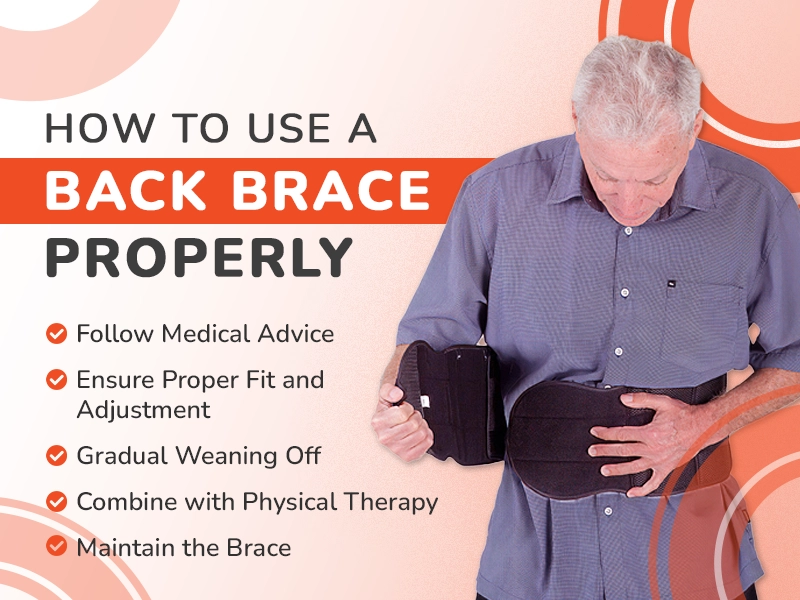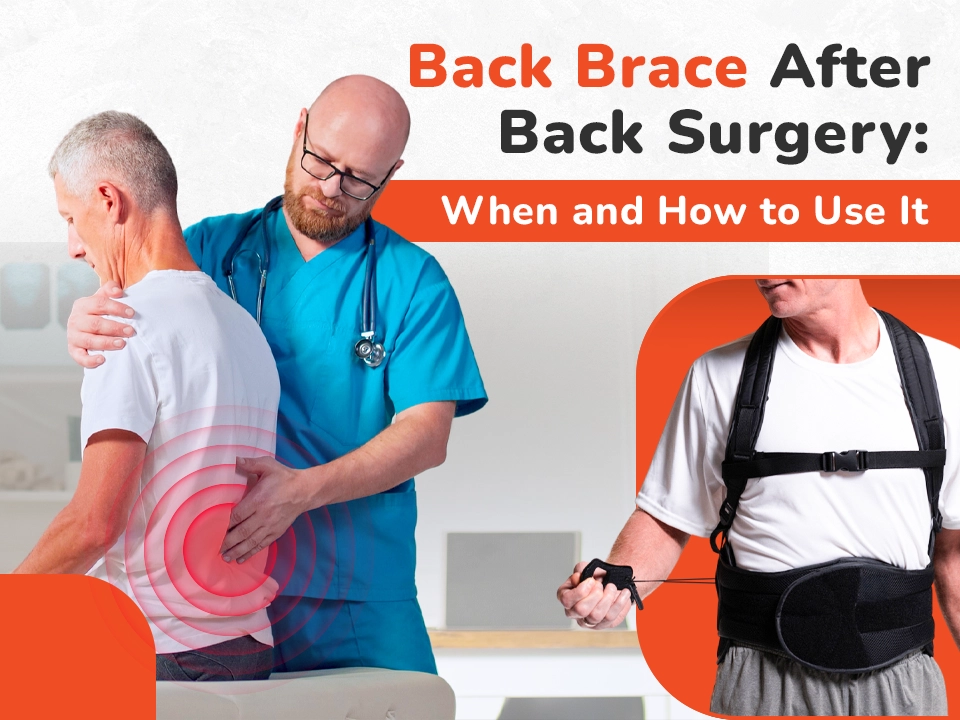Back Brace After Back Surgery: When and How to Use It
Back surgery can be a crucial step in addressing chronic pain, spinal issues, or injuries, but recovery often requires additional support.
A back brace is an essential tool in the post-surgical healing process, aiding in stability, reducing strain, and providing pain relief. Its role goes beyond support; it promotes faster and safer recovery by protecting the surgical site and encouraging proper posture. Understanding the right time and way to use a back brace can make a meaningful difference in your recovery journey, ensuring you regain mobility and strength effectively.
The Role of a Back Brace in Post-Surgical Recovery
A back brace serves as a protective and supportive device that ensures proper alignment and minimizes strain on the surgical site. By creating a stable environment, it helps the body heal while preventing complications such as re-injury or improper posture.
Key Functions of a Back Brace
- Immobilization: Prevents unnecessary or harmful movement that could disrupt the healing process.
- Pain Relief: Reduces tension in surrounding muscles, easing discomfort and allowing you to move with greater confidence.
- Support for Weak Muscles: Provides added stability as the muscles surrounding the spine regain strength and functionality.
- Improved Posture: Encourages correct spinal alignment, which alleviates stress on other parts of the spine and adjacent muscles.
- Faster Healing: By minimizing strain, a brace creates an optimal environment for tissue repair, speeding up recovery.
When to Use a Back Brace After Surgery
The necessity and duration of back brace use depend on the type of surgery and your surgeon’s recommendations. Certain surgical procedures particularly benefit from the use of a brace.
Common Surgeries Where Back Braces Are Used

- Spinal Fusion: A brace is often required to keep the spine immobilized, ensuring the fusion solidifies properly.
- Discectomy: Following the removal of a herniated disc, a brace supports the healing spine and minimizes strain during daily movements.
- Laminectomy: After decompression surgery, a brace stabilizes the back as the body adjusts to changes in spinal structure.
- Vertebral Fracture Repair: Braces are crucial for maintaining stability in the spine during the healing phase, reducing the risk of misalignment or re-injury.
Typical Usage Timeline
- Immediately After Surgery: The brace is worn consistently, especially during movement or any activity that could strain the back.
- First Few Weeks: Brace use is encouraged during activities like walking, sitting for long periods, or standing to prevent unnecessary strain.
- Later Stages: As healing progresses, brace usage may be gradually reduced under your doctor’s supervision, transitioning to activities that help strengthen the back muscles.
A well-timed and guided approach to back brace use ensures maximum support without hindering the natural healing process. Always follow your healthcare provider’s recommendations to optimize recovery.
Types of Back Braces for Post-Surgery
Back braces are designed to cater to different recovery needs based on the type and severity of surgery. Choosing the right type of brace ensures optimal support and healing.
1. Rigid Braces
- Provide maximum support and immobilization, ideal for stabilizing the spine after major surgeries like spinal fusion or vertebral fracture repair.
- These braces completely limit movement, ensuring the surgical site remains undisturbed during the critical healing phase.
2. Semi-Rigid Braces
- Allow limited movement while providing substantial support, making them perfect for less invasive procedures such as discectomies.
- They strike a balance between stability and mobility, helping patients gradually return to normal activities.
3. Corset Braces
- Lightweight and flexible, offering moderate support to the lower and mid-back.
- Often prescribed for mild surgeries or as a transitional brace during recovery, these braces provide comfort without overly restricting movement.
4. Soft Braces
- Designed for gentle compression and mild support, these braces are ideal for managing pain or offering light stabilization during the later stages of recovery.
- They are also suitable for post-operative patients transitioning back to full mobility while managing occasional discomfort.
How to Use a Back Brace Properly

Using a back brace correctly ensures its effectiveness in protecting the spine and aiding recovery. Follow these best practices:
1. Follow Medical Advice
- Always adhere to your surgeon or physical therapist’s guidelines for when and how to wear the brace.
- Understand specific instructions, including whether to wear the brace during sleep, walking, or other activities.
2. Ensure Proper Fit and Adjustment
- The brace should fit snugly but not be overly tight, as excessive compression can impede blood circulation or cause discomfort.
- Adjust straps or fasteners to maintain even support across the back and prevent slippage during movement.
3. Gradual Weaning Off
- As your recovery progresses, follow your doctor’s recommendations for gradually reducing brace usage.
- Slowly transition to exercises and daily activities without the brace to rebuild muscle strength and improve flexibility.
4. Combine with Physical Therapy
- Use the brace as a supportive tool while engaging in physical therapy exercises to strengthen your back muscles and improve posture.
- Wear the brace during challenging activities to ensure safety while working toward regaining full mobility.
5. Maintain the Brace
- Regularly clean the brace according to manufacturer instructions to maintain hygiene, especially when worn for extended periods.
- Inspect for signs of wear and tear, and replace or repair as needed to ensure continued effectiveness.
Benefits of Using a Back Brace After Surgery
A back brace offers multiple benefits that contribute to a successful recovery process and improve overall well-being:
1. Enhanced Recovery
By limiting movement and providing stability, a back brace creates an optimal environment for healing, reducing stress on the surgical area.
2. Reduced Pain
Alleviates post-operative discomfort by supporting the spine and reducing tension in surrounding muscles.
3. Prevents Re-Injury
Stabilizes the back during physical activities, minimizing the risk of accidental strain or re-injury, particularly during the vulnerable early recovery phase.
4. Encourages Mobility
Provides confidence and support for safe movement, allowing patients to gradually resume daily activities and physical therapy exercises.
5. Improves Posture
Promotes proper spinal alignment, preventing undue stress on adjacent areas and aiding long-term spinal health. Using a back brace effectively and combining it with a comprehensive recovery plan can significantly improve surgical outcomes and quality of life.
Common Concerns About Back Braces
1. Will Wearing a Back Brace Weak My Muscles?
Wearing a brace temporarily will not weaken muscles. However, prolonged use without physical therapy may lead to muscle dependency. Balance brace usage with strengthening exercises.
2. Can I Wear a Back Brace While Sleeping?
Typically, braces are not worn during sleep unless recommended by your doctor. Removing it at night allows the skin and muscles to relax.
3. Are Back Braces Covered by Insurance?
Most insurance plans, including Medicare, cover back braces if deemed medically necessary. Consult your healthcare provider and brace supplier for eligibility details.
4. How Do I Clean and Maintain My Back Brace?
Back braces should be cleaned regularly using mild soap and water to prevent odors and skin irritation. Always follow the manufacturer’s care instructions and avoid submerging rigid braces with metal components in water.
5. How Long Should I Wear a Back Brace Each Day?
The recommended duration depends on your condition and doctor’s advice. In most cases, back braces are worn for a few hours a day during physical activity and removed for rest.
6. Can I Exercise While Wearing a Back Brace?
Yes, many patients are encouraged to perform low-impact exercises while wearing their brace, especially during recovery. Consult your doctor or physical therapist to ensure the exercises are safe and beneficial.
Read More: Daily Benefits of Wearing a Back Brace
Tips for Maximizing Back Brace Benefits
1. Wear Comfortable Clothing
Layer the back brace over a thin, breathable shirt to prevent skin irritation and ensure a comfortable fit. Avoid bulky clothing that could interfere with the brace’s function.
2. Stay Active
Engage in light, doctor-approved activities to maintain mobility, improve circulation, and prevent stiffness. Gradually increase activity levels as your recovery progresses, using the brace for added support during more strenuous tasks.
3. Monitor Progress
Keep track of your recovery milestones and any changes in your pain or mobility levels. Regularly update your doctor on your progress so they can make necessary adjustments to your treatment plan or brace usage.
4. Replace Worn-Out Braces
Inspect your back brace regularly for signs of wear, such as stretched straps or cracked components. A worn-out brace may lose effectiveness, so replace it promptly to ensure consistent support throughout your recovery period.
5. Combine With Physical Therapy
Pair brace use with physical therapy exercises to strengthen your back muscles and enhance flexibility. This combination can accelerate recovery and reduce the risk of muscle dependency on the brace.
How Heal Medical Supply Can Help
At Heal Medical Supply, we’re committed to supporting your recovery journey with top-quality back braces and expert assistance tailored to your unique needs.
Why Choose Us?
- Wide Range of Braces: We offer a comprehensive selection of back braces, including rigid, semi-rigid, and soft models, catering to various stages of post-surgical recovery and conditions.
- Expert Guidance: Our knowledgeable team is available to help you choose the ideal brace, ensuring a perfect fit and maximum comfort.
- Insurance Assistance: Navigating insurance claims for Medicare or private coverage can be daunting, but we handle the paperwork to ensure a hassle-free experience.
- Ongoing Support: Beyond providing braces, we offer continued resources and advice to help you get the most out of your orthopedic device and recovery plan.
Contact Us Today
Take control of your recovery with Heal Medical Supply. Explore our extensive range of high-quality back braces and get personalized support to meet your post-surgical needs. Whether you’re managing recovery from spinal fusion, discectomy, or other procedures, we’re here to ensure you find the right brace for your journey.
Conclusion
A back brace is an indispensable tool for achieving a safe and effective recovery after back surgery. By stabilizing the spine, alleviating pain, and promoting mobility, it enhances the healing process while reducing the risk of complications. With guidance from your healthcare provider and the reliable solutions offered by Heal Medical Supply, you can confidently navigate your post-surgical journey toward improved health and mobility.
For personalized assistance and expert recommendations, contact Heal Medical Supply today. Let us provide the support you need to make a smooth transition to a pain-free and active lifestyle.



